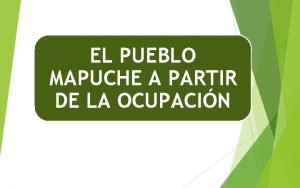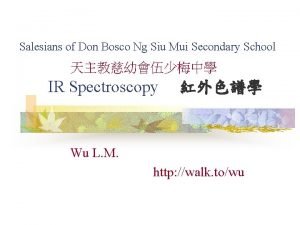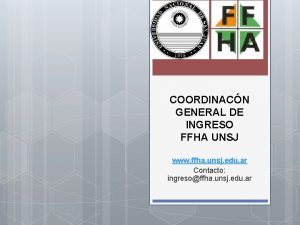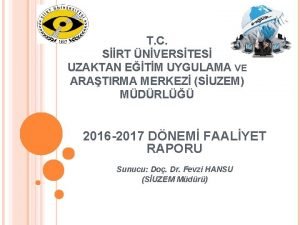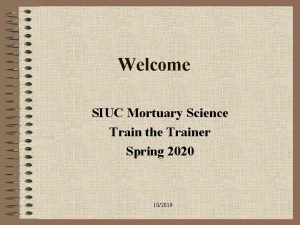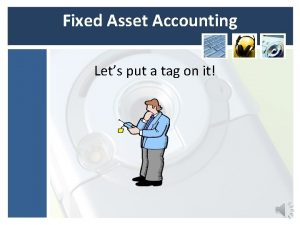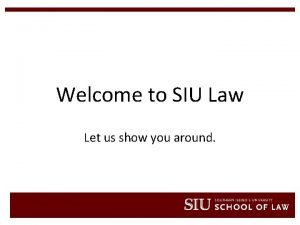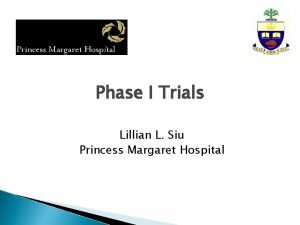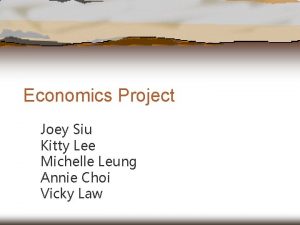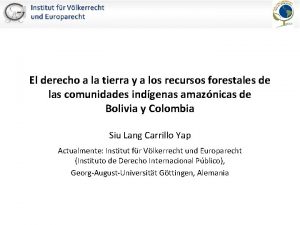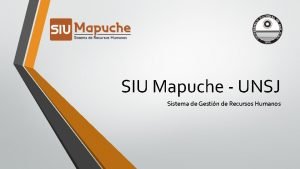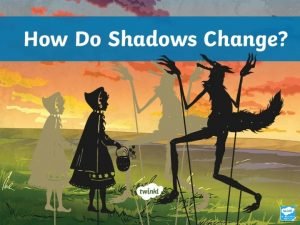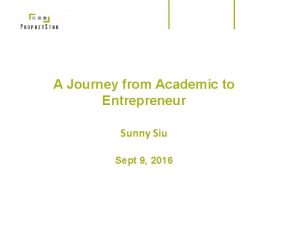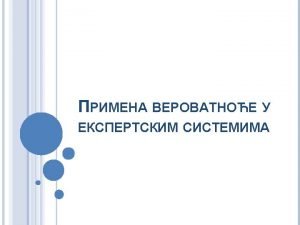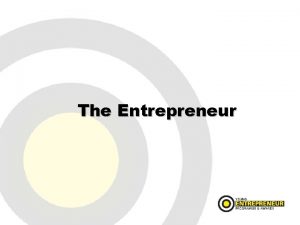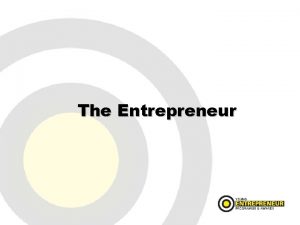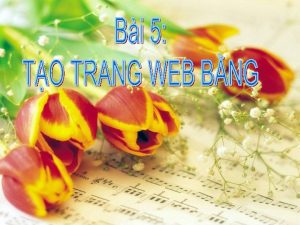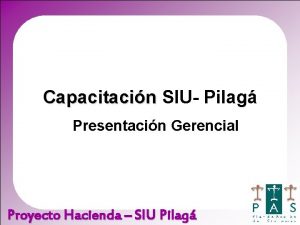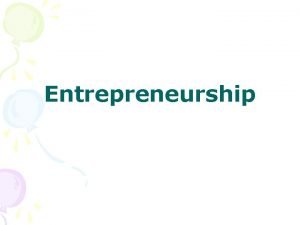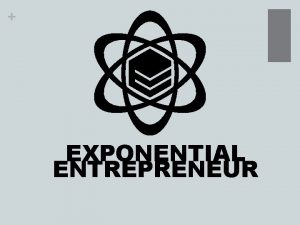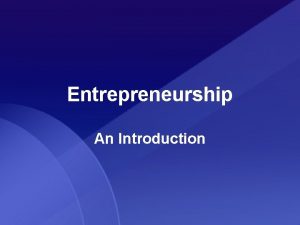A Journey from Academic to Entrepreneur Sunny Siu




















- Slides: 20

A Journey from Academic to Entrepreneur Sunny Siu Sept 9, 2016

Outline • Academic vs Industrial R&D • 1991 -2000: – Emergence of the Internet. – (first) Internet investment bubble. • 2000 till now: – Building technology businesses and the lessons learned. – HK/China vs US technology environment. • Disruptive IT technologies – Impact on industries e. g. health care & financial. 2

Academic vs Industrial R&D • Academic Research – focus on creation of ideas: some interesting, some may not have practical applications, but some had major commercial impact • Implementation of ideas is not the primary focus. – mostly on well-defined problems, sometimes with simplified assumptions/constraints • Interesting, fundamental problems with elegant or optimal solutions. – Universities sometimes don’t have access to facilities that industries have (e. g. budget constraint). – End results of research are publications, rather than a commercial product • New ideas by themselves do not create any commercial value or impact until they turn into commercial products. 3

Academic vs Industrial R&D • Industrial R&D – Nature of problems • Lots of real-world constraints and sometimes ill-defined. • Might not be interesting from an academic point of view - solution might not be elegant. – Want a most cost-effective solution, not necessarily the most “optimal” solution – Want a “good enough” solution that is cheap to implement, rather than an “optimal” solution that is expensive. – Any new solution would need to address the legacy – the huge installed base of existing systems and solutions. – Might not need the kind of “rigor” required by academics • Use of heuristics. • Getting a good (and least costly) solution is more important than the underlying theory. 4

My academic research topics (1991 -2000) – Neural computation/Artificial Intelligence (Ph. D. thesis) – Flow control/traffic management for ABR service in ATM (asynchronous transfer mode) networking. – TCP/IP traffic management • Accelerating TCP flows across WAN. • Packet discarding & virtual queuing techniques. – OSPF – dynamic shortest path algorithms for routing in IP networks – Optical networking (joint work with MIT Lincoln Lab All Optical Networks, co-PI on DARPA NGI initiative) – resource allocation. – Wireless communication (W-CDMA, funded by NTT Do. Co. Mo) – code scheduling. – MIT Auto-ID center – Founding Research Director, Internet of Things (Io. T). 5

TCP/IP traffic management and WAN acceleration – A solution for accelerating TCP/IP flows over a WAN (wide area network) with network segments of different bandwidths. • P. Narvaez & K. -Y. Siu “New techniques for regulating TCP flow over heterogeneous networks”, Proceedings 23 rd Annual Conference on Local Computer Networks. LCN'98. • US Patent “Method for regulating TCP flow over heterogeneous networks” US 6252851 B 1 (filed March 1998). – Challenge: addressing the legacy issue - how to accelerate TCP/IP connections without changing source and destination system behavior? – Solution: implementation of “acceleration gateway” at network edges for regulating TCP acknowledgement packets – acknowledgment bucket scheme. – Key technologies for the WAN acceleration market • Pioneered by Packeteer – a startup founded in 1996 and went IPO (Nasdaq) in 1999. • Market size ~ US$ 1 B. 6

Computing Shortest Paths for Routing in IP Networks – In IP networks, every router forwards an IP packet “hop by hop”. The “next hop” is determined by computing the shortest paths to its destination routers (OSPF protocol). • OSPF is commonly implemented using the Dijkstra’s algorithm (1959). • The resulting shortest path tree guarantees no routing loop. – Common commercial implementation: • Every time a link state in the network changes, the shortest paths are recomputed from scratch (static algorithms). • Causing network instability – a new path is created even if the “distance” between two node does not change. – New question: when link state changes, how to find a “stable” network route with the most “efficient” algorithm. 7

F D 11 7 D 2 2 4 B F 12 4 C 10 5 E 2 B 6 4 7 5 C E 2 10 8 ->2 0 2 4 8 7 9 9 A (source) Fig 1. Shortest path tree before link change 10 7 2 0 A (source) Fig 2. Shortest path tree after link change

A A 2 7 10 7 C 8 ->2 B 4 4 4 C 5 B 5 E E D 2 10 4 2 2 2 F D F Fig 3. The ball-and-string models for the networks in Fig 1 (left) and Fig 2 (right)

Computing Shortest Paths for Routing in IP Networks – P. Narvaez, K. -Y. Siu, H. -Y. Tzeng, “New dynamic SPT algorithm based on a ball-and-string model”, IEEE/ACM Transactions on Networking, Volume 9 Issue 6, December 2001. (work done in 1998) – New solution: use of dynamic algorithms guided by physics (gravity) • Recast the shortest path problem and constraints into a ball-and-string model. • By emulating the physical dynamics of the model (gravity), it gives us a new search criterion (that of minimum distance change) to which direction the information about link changes should be propagated. • Our new algorithm can be seen as a simulation of how a model of ball and strings would physically reconfigure itself under gravity. – Academic challenge: proving the algorithm’s correctness – that it always finds the shortest paths among infinitely many possible cases. – Our new algorithm makes the minimum changes to the existing routes and have the best known computational efficiency • up to several thousand times faster than a typical implementation by software (V Jacobson). – But OSPF is only a small part of an overall router implementation. 10

Internet – the emergence and first investment bubble – Triggering factor in driving the popular use of Internet in the 90’s. • Invention of the Mosaic browser by NSCA at the University of Illinois, Urbana. Champaign (1992). • Commercialization of the browser by Netscape Communications Inc. – Netscape IPO in 1995 before it became profitable. • First day of IPO in 1995, stock offered at $14/share, closing price at $58. 25, giving it a valuation of $2. 9 B. • Acquired by AOL for over $10 B in 1999. – Yahoo went IPO in 1996 • Created by Jerry Yang an David Filo at a dorm room in Stanford U. in 1994. • Reached a market cap of ~US$100 B in 2000. – Deregulation of the Telecom Industry in the US in 1996 • Allowing long-distance telephone companies such as AT&T, as well as cable television and other start-up companies, to begin entering the local telephone business. Regional carriers had to allow new competitors to link with their networks, and could enter the long-distance business. – The “Y 2 K bug” • About US$300 B spent worldwide on upgrading their IT equipment. 11

Experiencing the first Internet bubble – Successes of Amazon and Ebay attracted many “dot-com” companies • Attracting “eyeballs” or web page visits without a real revenue model. • E. g. Webvan, Pets. com, e. Toys. com etc. – Demand for “never-ending” demand for bandwidth Cerent (founded in 1997) acquired by Cisco for US$7. 2 B in 1999. Cisco worth ~$400 B in 2000, now ~$150 B. Juniper Networks ~US$80 B in 2000, now ~$9 B. Sycamore (founded by MIT researchers) went IPO in 1999, reaching a peak market cap of $18 B. Closing down in 2012 (sold to private equity for ~$100 M). • Other tech companies, e. g. Redback, Sonus, etc. • • – “Real” technological advances • • • ADSL/VDSL Gigabit Ethernet/IP networking Wireless communication – W-CDMA & OFDM (Qualcomm) Google search engine (1998) Akamai caching service (MIT) – market cap ~$50 B in 1999, now ~$9 B. 12

Transitioning from Academic to Startup (2000 -2001) – Leave of absence from MIT (2000), joining a venture capital/technology incubator Raza Foundries as “Chief Scientist” • Just sold a company (incubatee) Yuni Networks (semiconductor) to AMCC for over US$150 M with 20 employees and “power point” presentation – Seeing crazy “M&A” (merger and acquisition) activities almost on a weekly basis in 2000. – Venture capital is almost “free “ – as long as you have an idea and a credible founding technology team. – Amateurs became venture capitalists. – Raza Foundries raised US$175 M to invest in companies • With the goal of selling the “incubatee” at a high valuation to Cisco and the likes. – The technology bubble started to burst when Cisco missed its revenue forecast in Q 4’ 2000. – The 9/11 terrorist attack in NY in 2001 and the following recession dried up most technology investment funds • Raza Foundries discontinued business in 2002. 13

Founding technology startups – Si. Silk Networks – Seeing the success of Yuni Networks, creating another switch fabric startup Si. Silk Networks in 2000 with a better switch architecture • Based on a new switch architecture designed with my student. – Hired a team of 30 ASIC engineers to develop the switch fabric chip sets. – First chipsets out in 18 months, 180 nm IBM fab, 80 Gbps switching throughput. – No marketing and sales, with the goal of selling the company to other large semiconductor/system companies. – Spent about US$15 M-20 M. Business discontinued in 2002. 14

Founding technology startups – RMI – In 2002, raised ~US$100 M to co-found RMI • Combining 3 different teams from Raza Foundries to build 3 different chip sets: multi-core processors, Ethernet switches, SDH/Ethernet service mappers. • Later discontinued Ethernet switch and SDH mappers products. • RMI spent about US$200 M over 7 years. – Milestones • Acquiring Sandcraft in 2003. • Acquiring Alchemy from AMD in 2006. • Revenues from these two acquired products sustained the business until 2009. – Coming to China in 2003 for business opportunities • Engaging with Huawei, ZTE, etc. • Developed a team of ~50 employees in China for applications support and development, sales support on multi-core processors. – RMI acquired by Net. Logic (NETL) for ~US$200 M in 2009 • Broadcom offered to buy NETL for US$3. 7 B in 2011 (transaction closed in early 2012). 15

Founding technology startups – lessons learned – Developing new technologies that can turn into successful products or services. – Success is measured by “commercial values” – revenues & profits, sustainability of the business. – Critical questions • what is the market segment, who are the customers, how to sell into these customers - products themselves do not sell by themselves. • Differentiation against competitors. • Go-to-market and revenue plan. • Investment required to sustain the business, when can the business turn profitable, what is the exit strategy of your investors. 16

From Academic to Entrepreneur – lessons learned • Understand market dynamics - competitors, sales channels, not only technologies. • Understand how customers are going to transition from legacy systems to your new solutions, what are the risks involved. • In the IT sector, question whether your customers will develop the same solution by themselves (buy vs. develop their own). Is it worth their own efforts for development, more control of the IP? • As a founder in the startup, you need to deal with 3 different types of people – customers, employees and investors/shareholders. • Think hard on the investment needed to sustain the business – Revenues on first product/service always come later than you expected. – Make sure you have enough money before the next round of capital comes. New investment funds will always come later than expected. – Best if you can find a major customer to invest (strategic investment). • What investors have in mind – what is the exit and what is the return? 17

Technology Startups – HK vs US • Access to venture capital – Limited access to large VC funds and knowledgeable investors. – Lack of technology investment ecosystems. – Investors focus on shorter-term return. • Products/Solutions need to address a worldwide market, not just a local market – HK market is too small. – Need to have a plan to address China/Asia Pacific market and beyond. Take advantage of the huge market in China. • US and European encourage university professors to become “academic entrepreneur” – HK universities might want to reconsider its policies on governing professors and their compensation/promotion – Should encourage collaboration between professors and industries in mainland. 18

New trends in IT Infrastructure Traditional Data Centers Management Software Defined Data Centers Software Solution management Major Cost Hardware Game Changes Cost Reduction by Automation Software Hardware Commodity Intel & ARM Servers Major Cost Reduction 19

Disruptive Changes in the IT industry • Cloud Computing – computing as a utility – virtualization, VMware, AWS, Openstack • Explosive data generation creates explosive demand for high-speed access to data storage and bandwidth – New flash storage offers 100 times more IOPS than traditional hard drives and lower power consumption. • Continued demand for more computing power – Big data analytics – VR/AR – Artificial Intelligence applications • What happens to Moore’s law? • “Block Chain” – distributed ledger technology without requiring a central point of control – Disruptive change to financial industry. – Lots of legal & compliance issues. • Big data analytics and AI – IT for enhancing health care delivery. 20
 Sunny siu
Sunny siu Siu mapuche
Siu mapuche Ng siu mui
Ng siu mui Siu ffha
Siu ffha Siuzem giriş
Siuzem giriş Siu mortuary science
Siu mortuary science Siu naturales unsa
Siu naturales unsa Siu ais
Siu ais Siu law library
Siu law library Hed human equivalent dose
Hed human equivalent dose 101 dim sum
101 dim sum Joey siu
Joey siu Siu thesis template
Siu thesis template Siu lang carrillo yap
Siu lang carrillo yap Siu ffha
Siu ffha Daughter of mary help of christ siu ming
Daughter of mary help of christ siu ming Dr wong siu wang
Dr wong siu wang Preinscripcion universidad nacional de salta
Preinscripcion universidad nacional de salta Sunny cloudy rainy snowy windy
Sunny cloudy rainy snowy windy Sunny places to live
Sunny places to live Sunny days are lovely homework
Sunny days are lovely homework

